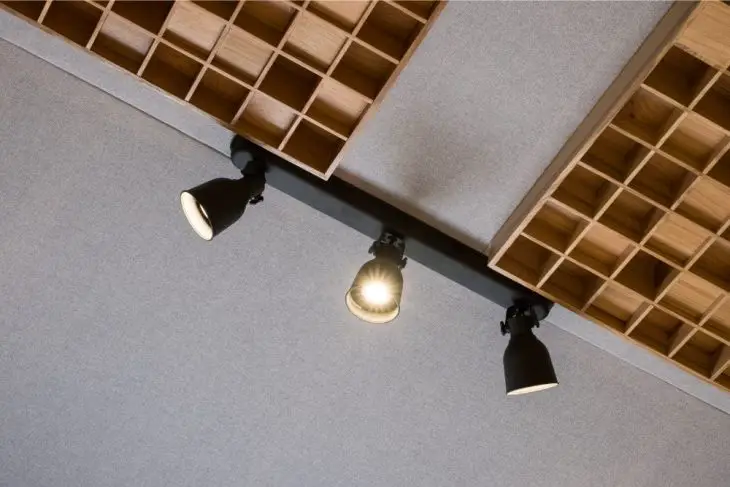Unwanted noise can be a real hindrance, especially if it’s coming from a source that you can’t control, such as an upstairs neighbor.

So, instead of having to put up with the unwanted noise interfering with your downtime and relaxation – is there anything that can be done to soundproof between the floors?
If you’re currently asking yourself this question, then rest assured that you’ve clicked on the right article!
Whether you’re trying to achieve those restful eight hours of sleep or you simply want to be able to unwind from a busy day in a peaceful, quiet environment, we’re here to lend you a helping hand.
In order to ensure that you can put a stop to the noise for good, below, we’re going to be talking you through some of the easiest ways that you can soundproof between existing floors below.
From acoustic panels to sealant – we’ve made sure to cover all bases. So, whenever you’re ready, let’s jump right in.
Option One: Soundproof Your Ceiling With Acoustic Tiles
Kicking things off, one of the easiest ways that you can significantly reduce the amount of noise traveling into your room is by soundproofing your ceiling with something known as acoustic tiles.
If you’ve never heard of acoustic tiles before, they are padded squares designed to be applied to walls, windows, and even doors in order to act as a sound barrier between one room and another.
So, in other words, they’re a perfect remedy for muffling noise coming from another room.
What’s more, acoustic tiles are designed to not cause any damage to the surface that they are applied to, which means that if you ever wanted to remove them, you wouldn’t have to worry about having to repair your walls underneath.
As soon as you have installed these acoustic tiles, you should notice that the noise coming from upstairs should be significantly reduced, if not undetectable entirely.
Interested in trying this method out for yourself? You’d be making a good decision to check out the Fstop Labs Store Acoustic Foam Panels.
Featuring an innovative “3D” design, these acoustic foam panels from Fstop Labs will be able to offer you 2 inches of foam that will ensure a high level of sound control across your existing floors.
Not just that, but unlike other acoustic foam panels on the market, these from Fstop Labs have been designed to also reduce any reverb alongside noise, which will ensure that unwanted echoes or vibrations will also be kept at a minimum.
Option Two: Soundproof Your Flooring With Noise-Cancelling Carpet
If you aren’t experiencing any noise issues from a sound source above, then you’re going to need to take the necessary steps to ensure that your flooring has been adequately soundproofed in order to reduce the noise coming from below.
Unfortunately, acoustic tiles aren’t designed to act as flooring, so in order to deal with the sound problem, you’re going to need to consider alternative solutions.
One of the best ways that you can do this is by opting to get new flooring. If you’re able, we strongly recommend that you opt to install a noise-canceling carpet, as this will serve as a permanent solution to your noise problem.
While this might not be a viable option for everyone, if you live in an apartment and the noise issue is coming from a neighbor, then investing in a soundproofing carpet is a great way to help to prevent unwanted noise from traveling into your home.
However, if you do not wish to reinstall new flooring to deal with the noise issue, a more affordable way that you can remedy the issue is by opting to add a thick rug to your floor.
While this might not be able to completely cancel out the sound, adding a thick rug to your floor will help to prevent the sound from below traveling up into your room, and will allow you to enjoy a more quiet and peaceful environment.
If possible, we recommend that you opt for a thick rug in order to raise the effectiveness of the sound muffling, and if possible, try and select a rug that is big enough to cover your entire floor (or at least the majority of it!).
Option Three: Add Insulation Between The Floors
Last but certainly not least, another way that you can effectively cancel out unwanted noise from above or below is by opting to add insulation between the floors.
In order to effectively do this, the ceiling’s drywall will need to be removed so that the insulation can be successfully installed.
To do this safely, the drywall will need to be removed and then furring strips will need to be immediately attached to the joists in order to maintain the overall structure of your ceiling and prevent anything from falling through.
Once this has been done, the fiberglass or wool insulation will then be able to be installed into the inner area of the ceiling, so that it is positioned directly underneath the floorboards of the above room.
Once this has been done, new drywall can then be installed, before then finishing off with an acoustic seal.
If you’re interested in trying this method, then it’s very important that you make sure to hire a professional who will be able to add the insulation for you.
The last thing that you want to do is to pull up the floorboards and install the insulation incorrectly, as that will only lead to a costly repair bill.
